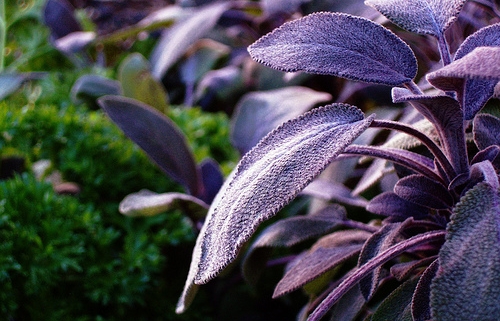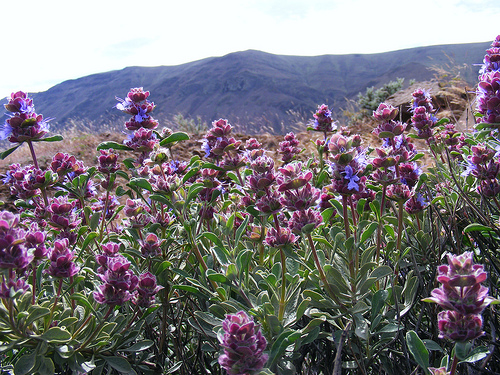My Favorite herbs Aka Sage
Sage (Salvia officinalis) is a shrubby perennial that’s not only an obvious herb choice for the kitchen, but it’s a great garden plant in its own right. It’s leaves have a thick, “bumpy” texture, and feel rather fuzzy. Depending on the variety, foliage colors can be bright green, blue-green, purple, or edged with cream or gold (“variegated”).
From spring through mid-summer, it blooms with small, blue-violet or lavender flowers which aren’t show-stoppers in our eyes, but they are extremely attractive to birds, butterflies, bees, and other pollinating insects and we gardeners applaud that. Sage is an evergreen herb will survive through the winter in zones down to 7, and it’s one of the easiest plants to grow. All of the attributes above puts sage at the top of my list for favorite garden herbs.
If left to it’s own devices in a loamy garden bed, sage will grow from 1′-3′ tall, but planted in a container it tends to stay much smaller. Plus, it’s simple to control the plant’s size as you harvest the stem and leaves. The flavor and scent is described as earthy, rich, and spicy.
Tips for Growing Sage
Success is almost guaranteed when you purchase sage as a one year start from a local nursery or garden center. When you transplant it from it’s nursery pot your garden or other container, be sure not to plant it too deeply into the soil. The crown of the plant (the place where all the stems meet at the base of the plant) should sit just above soil level.
Like many herbs, sage doesn’t like it’s feet “wet,” so plant it in a well-draining soil. It thrives in the sun, but doesn’t have a problem tolerating spots with light shade, especially if you live in an extremely hot area. Water sage regularly until it becomes established in it’s new home. After that, it’s happy with moderate watering.
Additional helpings of compost throughout the year cheers them up, and I don’t bother actually fertilizing, although many gardeners will at the beginning of spring. After a few seasons, you’ll want to trim off any woody parts to encourage growth and keep it looking its best (there won’t be any new growth on the woody parts anyway).
Harvesting Sage
You can begin harvesting sage leaves for the kitchen once you’ve seen some good growth on the plant, which means it’s matured. If your plant has over-wintered in a container, wait for the leaves to unfurl in early spring before harvesting.
Sage that’s been planted predominately as a kitchen herb (food) should have any flower spikes removed before they have a chance to flower. This is because the flowers will send a signal to the plant that it can slow down leaf production because it has met it’s goal for the season. We want to trick the plant into producing as many leaves as possible before it flowers in order to take advantage of a full harvest.

 NO
NO

 no
no no
no
Leave a Reply
Want to join the discussion?Feel free to contribute!